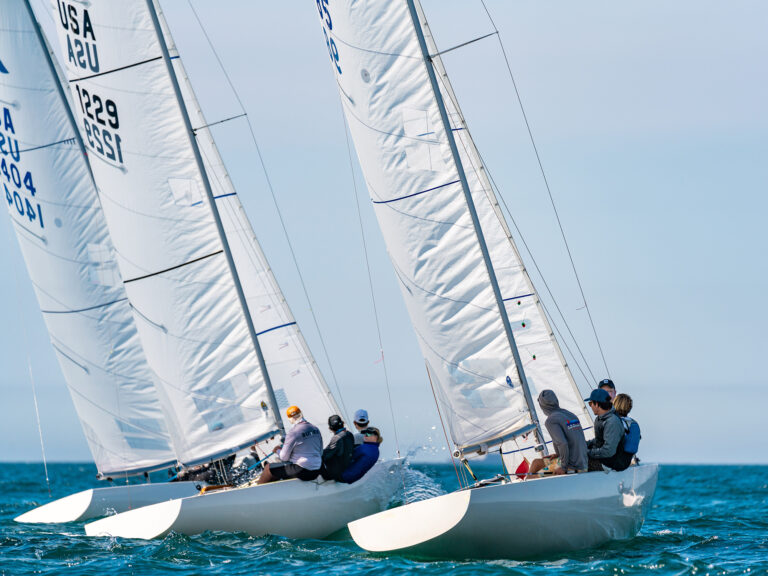We often hear apparent wind described using the analogy of a person sitting in a convertible car on a still day. As the car accelerates from zero to 20 mph, the apparent wind felt on their face will increase from zero to 20 mph. This is an excellent analogy for non-sailors, but a sailing boat is on a moving surface (the sea), while a car is on a fixed surface (the land), so there are a few other factors to consider when defining apparent wind. Apparent wind is the only wind you can measure directly on board your boat, and while it’s the wind you feel blowing across the boat, it’s actually a product of three other winds: ground wind, tide wind, and motion wind.
Ground wind is the wind that blows around the earth. It’s what we feel when standing on dry land and what we see on marine weather forecasts. Ground wind itself is of very little use to sailors because it doesn’t take into account the movement of the boat through the water, or the movement of the water over the earth’s surface. Remember, however, that this is the wind that an anchored committee boat is working with, so in tidal areas or areas with any current, the sailing wind can be dramatically different than what the committee is using to set a course.
Tide wind is the wind created by the motion of the water relative to the land. It is what we would feel if, on a still day in tidal waters, we dropped the sails and allowed the boat to drift on the current. Tide wind is therefore equal in strength to the current flow, but is opposite in direction.
Motion wind is the wind created by the movement of the boat through the water. For example, if we motored in any direction on a still day, the motion wind would be equal to our boatspeed but opposite to our heading, blowing directly onto the bow.
By combining the effects of these three winds we have our apparent wind. Fortunately your instrument system’s masthead unit measures apparent-wind angle and apparent-wind speed.
| ANGLE VS. DIRECTION |
|---|
| An important distinction to make on a sailboat is that any value that’s relative to the bow of the boat is usually referred to as an angle, for example, true-wind angle or apparent-wind angle. Any value that’s relative to an external point, such as north, is referred to as a direction, for example, true-wind direction. |
True wind is the term we most commonly use to describe our sailing wind, without the effects of the motion of the boat. On paper true wind is much easier to understand than apparent wind: It is the vector sum of the ground wind and the tide wind. Because true wind is the sum of these two winds, it’s important to remember that any changes you see in the true wind on your instruments are not just being caused by changes in the ground wind. True wind is also affected by changes in the tide wind.
True wind is what we call a derived number, not a measured number like apparent wind. This means we cannot physically measure the true-wind angle or true-wind speed on a sailboat. We need to calculate it using our apparent-wind angle, apparent-wind speed, and boatspeed (speed through the water, not speed over ground).
These measured numbers are put through something called “the wind triangle.” The end result is true-wind angle and true-wind speed. These calculations are much more useful to the sailor as they reference the sailing wind outside of the boat and allow us to think strategically.
If we add compass readings into this, we can then calculate the true-wind direction, which is considered to be the most useful tactical tool on any sailing boat because it gives us the most precise way of showing windshifts. It’s important to remember, however, that the true-wind direction refers to the sailing-wind direction, and that direction can be given in degrees magnetic or degrees true, depending on your compass output or the configuration of your instrument system.
That covers much of the big-picture theory surrounding the wind in which we sail, but there are real world factors that can leave even the most experienced racing sailors scratching their heads. The phrase “wind shear” will be familiar to many sailors because it’s often used to describe two phenomena: shear and gradient.
In an ideal world, the wind you’re sailing in would be like a moving block of air, uniform in direction and speed at all levels, but the laws of physics mean this is never the case. Air flowing around the planet slows as it comes into contact with the earth’s surface, so in our case moving air slows as it experiences friction from the water’s surface.
As the air slows it changes direction—this is wind shear. In the Northern Hemisphere the wind backs (shifts left) as it slows. The opposite is true in the Southern Hemisphere, where the wind veers (shifts right) as it slows. The difference between the Northern and Southern Hemispheres is due to the Coriolis Effect, but that topic is for another day.
Wind gradient is the slowing of the wind close to the water surface. It is most noticeable on spring days, when the water temperature is colder than the air temperature and mixing of the air does not readily occur.
In the Northern Hemisphere, you will recognize wind shear when you see wider wind angles on starboard tack. In some extreme cases, you may see your instruments stay on starboard tack even though the boat is sailing along on port tack. In this case look up the mast just to check.
If you have a heel sensor in your instrument package, check your heel angle. If your normal upwind heeling angle is 20 degrees in 12 knots of breeze, but you are sailing at only 15 degrees of heel (assuming you are sailing the boat well), then the air column is not well mixed and you are sailing in wind shear.
The question then becomes: What can you do with this wind shear? Understand that wind shear is not uniform. It’s dependent upon several different factors—ground-wind speed, air temperature, barometric pressure, and water temperature—so it changes daily, and even hourly in some cases. One thing that doesn’t change, however, is the wind direction. This will usually stabilize in the direction of the shear, so use this to your advantage. You can also talk to your trimmers; they will recognize the shear in the sails and will try to optimize the sail trim.
When sailing in wind shear, it’s important to recognize that you won’t be able to sail to your target numbers. You may have 10 knots of true-wind speed at the masthead but only 4 knots on the water. According to your instruments and your polars, you should be doing 8 knots boatspeed in 10 knots true-wind speed. The reality is that the actual wind speed in which the sails are operating is more like 7 knots. Therefore, your actual target boatspeed might be closer to 5 knots. In this situation heel angle is critical; it’s the first number you will see that makes sense of the situation.
Be cautious when calling a layline when sailing in wind shear as well. On starboard tack, your instrument’s true-wind angle will be wider than the actual true-wind angle, resulting in a late layline call. When sailing in significant wind shear you can use your current heading, plus your target-tacking angle, to calculate your opposite-tack heading.
Finally, as a navigator or a sail trimmer, you should take the time to understand wind shear and gradient, as any good sailor will be able to blame it for almost anything that goes wrong.
Miles Seddon, of the United Kingdom, worked for B&G from 2005 to 2013 before establishing himself as a consultant. While at B&G, he worked with Volvo Ocean Race (developing the electronic package for the VO65), Vendee Globe, and America’s Cup teams. He currently works with Team SCA in the Volvo Ocean Race, managing their performance analysis and instrumentation coaching.
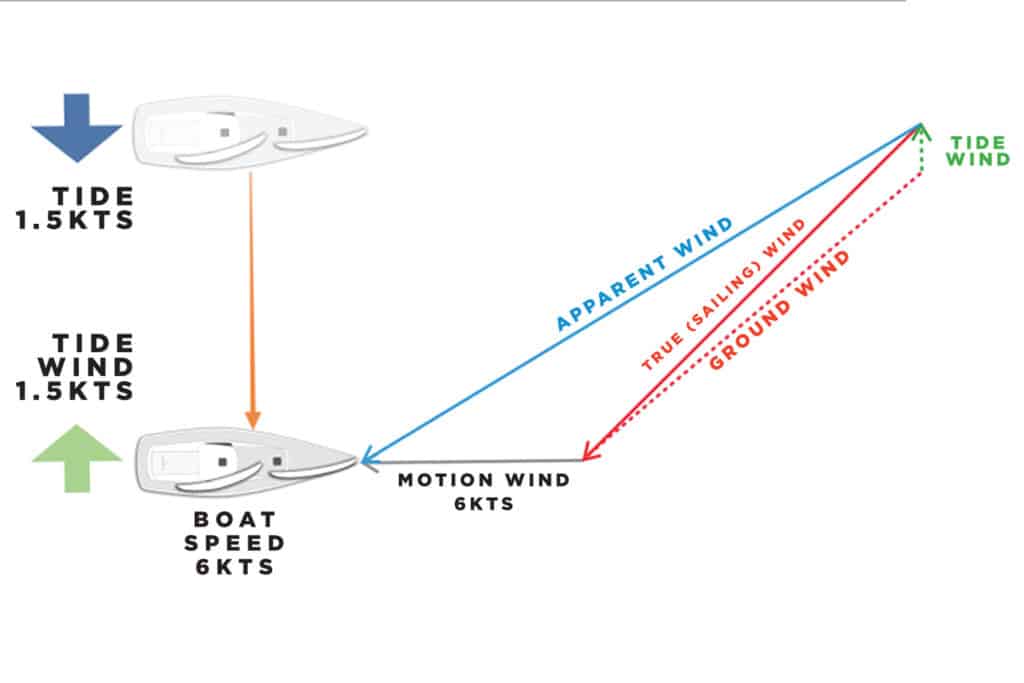
Apparent wind is one of the most useful tools in your tactical toolbox. Understanding how apparent-wind angle and speed are calculated is not complicated. The tide-wind strength and direction is equal and opposite to the tidal flow. Ground wind is the wind you feel onshore. The true wind, therefore, is a combination of tide wind and ground wind. Your motion wind (your speed through the water) combined with your true wind equals your apparent wind. Luckily, a properly calibrated instrument package can figure this all out for you.
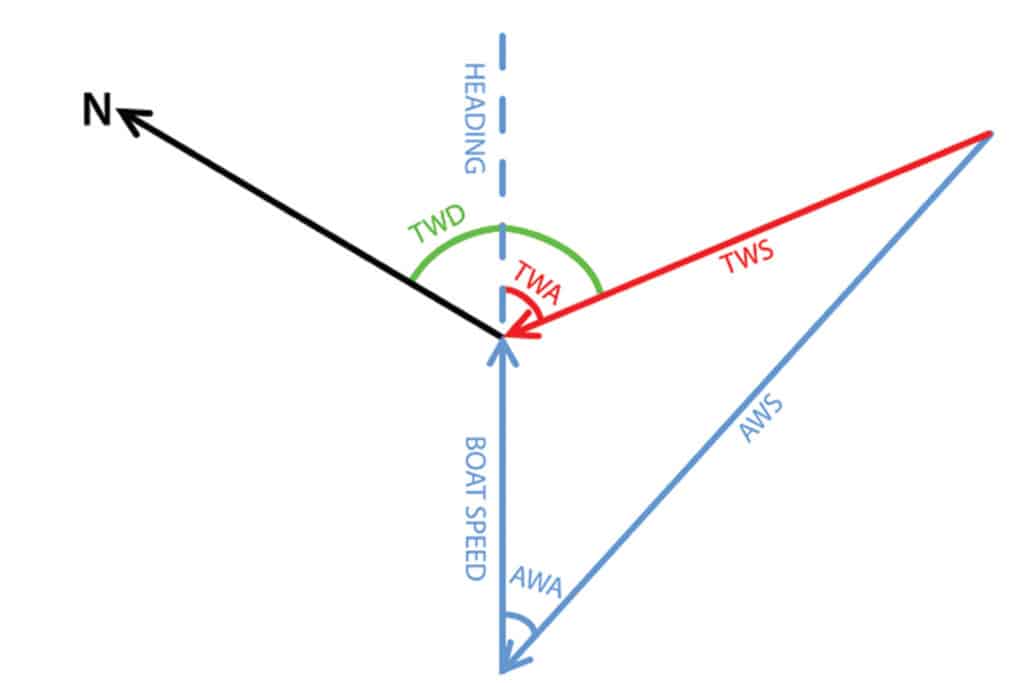
True-wind direction (TWD) is useful information for showing windshifts. It is a derived number, however, not a measured number like apparent wind. It must be calculated through the wind triangle, using apparent-wind angle (AWA), apparent-wind speed (AWS), and boatspeed. With the addition of heading, you can then calculate true-wind direction (TWD).
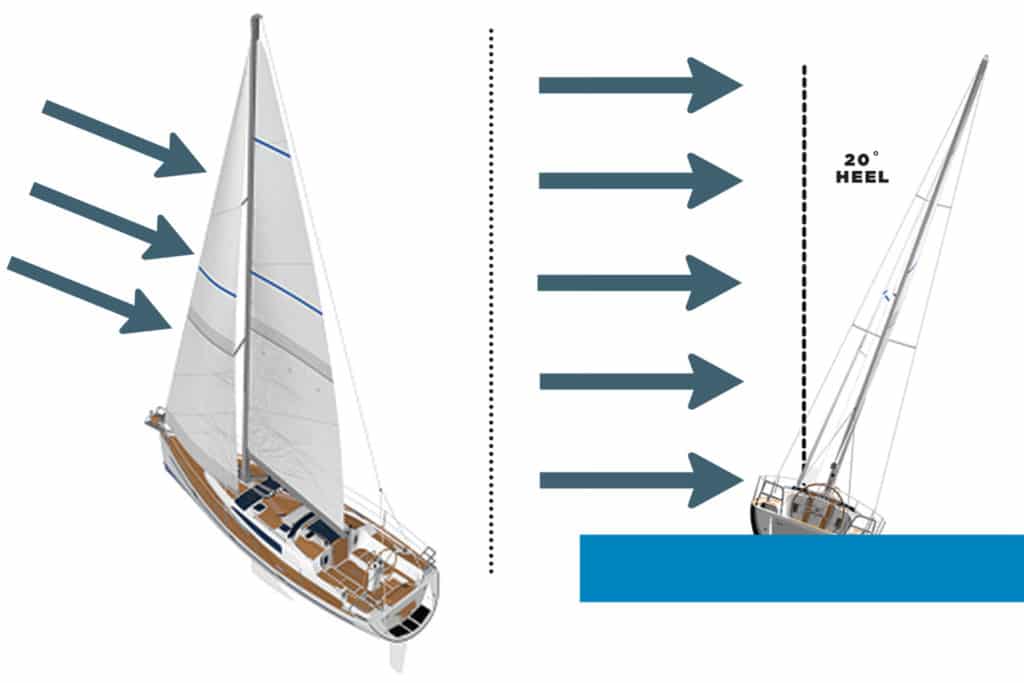
As air slows due to friction with the water’s surface, it changes strength and direction—this is wind shear. In an ideal world without shear, the wind would be uniform from the top to the bottom of the sailplan, and the boat’s heel angle would be greater than that of a boat experiencing wind shear and gradient in the real world (see next diagram).
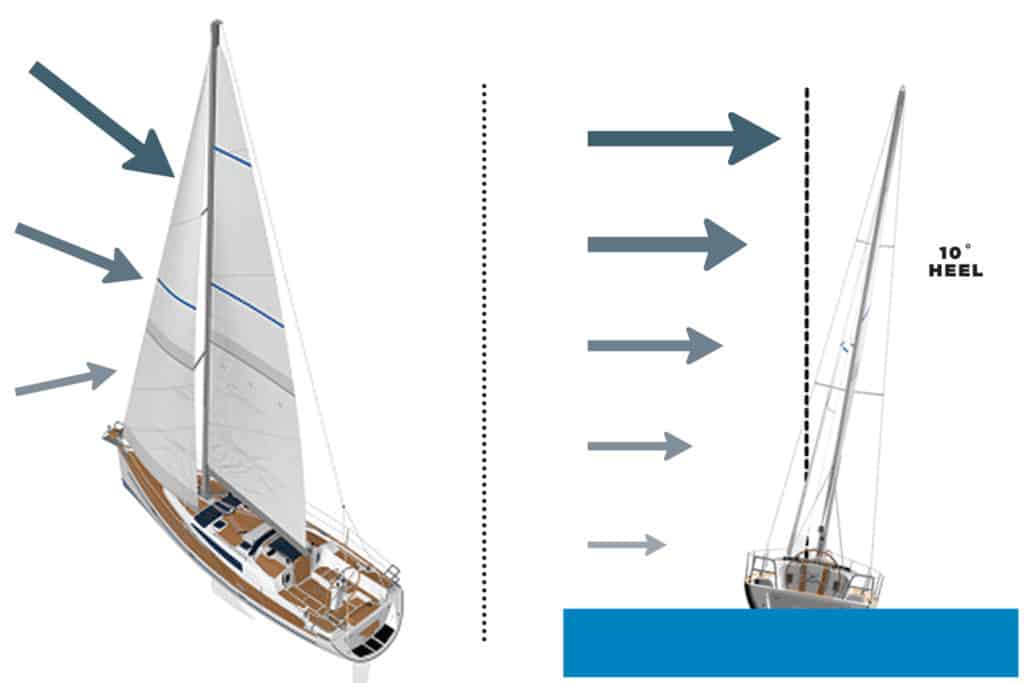
Wind shear and gradient will change the strength and direction of the wind from the top to the bottom of the sail plan, and the effects will be different on port and starboard tack. Your instruments will show this and it’s important to remember that even though your angles may read differently from tack to tack, they’re not wrong. Even without instruments you can use your heel angle and your sail trim to recognize wind-shear conditions.






